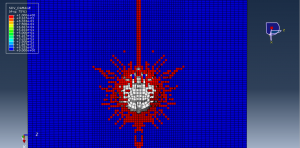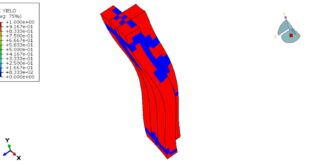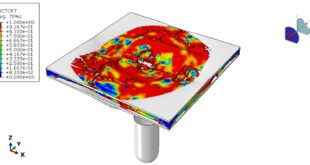In this tutorial, the Simulation oblique high-velocity impact of an aluminum rod to the silicon-carbide target in Abaqus has been investigated. The silicon-carbide target is modeled as a three-dimensional solid part. The aluminum projectile is modeled as a three-dimensional solid part. You can see a figure of the assembled parts below
The study of the interaction between two impacting bodies, known as impact dynamics or terminal ballistics has many crucial applications. Bullet impact on armor. An in-depth understanding of the deformation behavior of materials under impact loading helps not only in designing better products but more importantly saving human life. Knowledge of material response under impact loading will help in estimating, enhancing, and extending the life and performance of any structure. Impact dynamics broadly depends upon two primary variables, namely the geometry and material of impacting bodies
The response of metals to applied loading not only depends on strain but also on other parameters such as temperature, pressure, strain rate, etc. The Johnson-Cook (JC) model is a phenomenological model commonly used to predict the material response of metals subjected to high strain rate and impact loading. The JC plasticity and damage are used to model aluminum projectile behavior. Generally, ceramic materials are brittle in nature. They have high
compressive strength but low tensile strength and tend to exhibit progressive damage under compressive load due to the growth of micro
fractures.
The dynamic explicit step is appropriate for this type of analysis. Because of the internal failure, the surface-to-surface contact isn’t useful and instead of the input file capability is used to define a contract that considers the erosion during the impact. The symmetry boundary is applied to the symmetry zones. The initial velocity is selected for the aluminum projectile. The mesh should be fine especially around the contact zone
After the simulation, all results such as stress, strain, damage, ductile damage, failure, and … are available. You can see some figures for the results below







You can provide CAE, INP, and English video files of this simulation here. The cost of these files is Twenty-Four Euros. you can click on the bellow bottom to beginning the process
You can purchase the tutorial through a PayPal account, a Visa, or a Master card, just before payment, send me an email to this address: karampourp@gmail.com
 Abaqus tutorials Abaqus tutorials
Abaqus tutorials Abaqus tutorials




